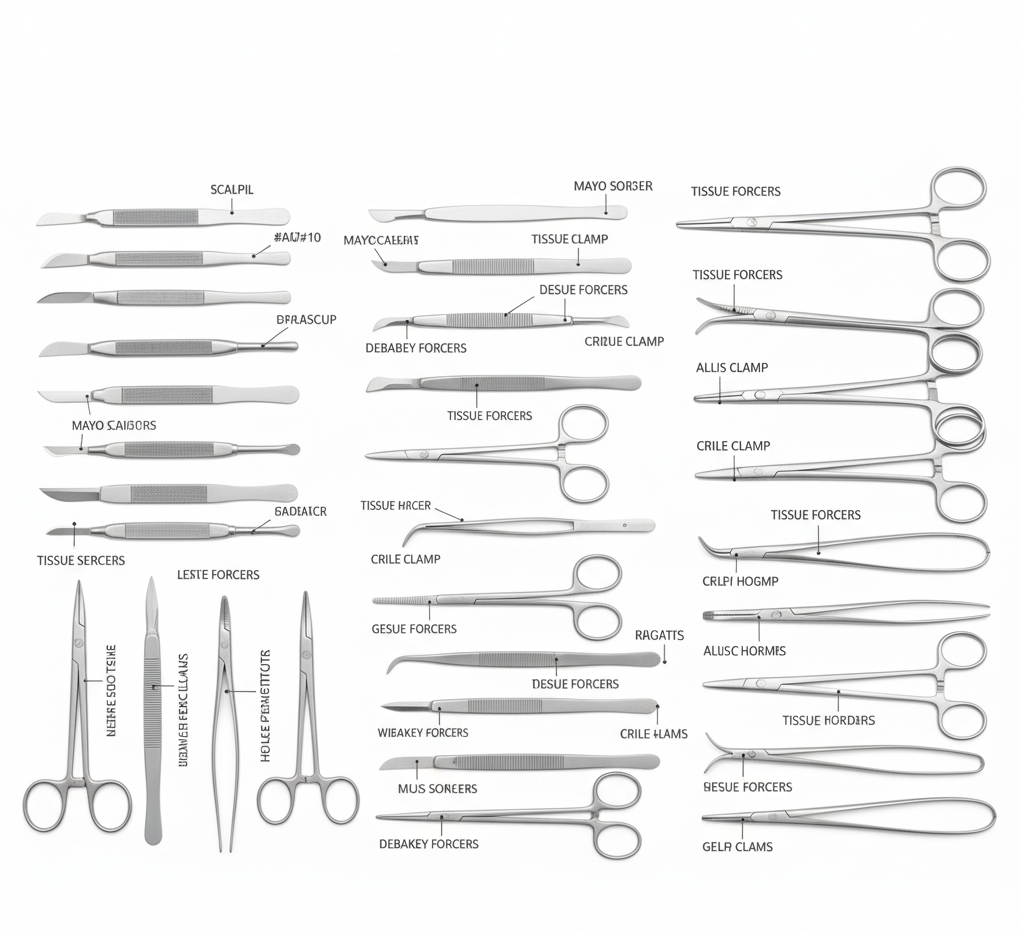Surgical instruments are essential tools used by surgeons and healthcare professionals to perform medical procedures safely and effectively. Each tool is designed with a specific function, and knowing the correct surgical instruments name is crucial for students, doctors, nurses, and medical suppliers.
This article provides a complete guide to the most common surgical instruments, their names, functions, and categories.
Why Surgical Instruments Names Are Important
Before diving into the list, it is important to understand why knowing the correct surgical instruments name is so valuable:
- Medical Education – Students can learn quickly when instruments are clearly named and categorized.
- Operating Room Communication – Surgeons and nurses must use correct names for efficiency.
- Purchasing Accuracy – Buyers and suppliers need correct names to avoid costly mistakes.
- Global Standards – Universal names make it easier to work across hospitals worldwide.
Main Categories of Surgical Instruments with Names
Surgical instruments are classified based on their use. Below are the most important categories and their commonly used instruments.
1. Cutting and Dissecting Instruments
These instruments are used to cut tissues, skin, or sutures.
Common Instruments (Name List):
- Scalpel – Sharp blade for precise cuts.
- Mayo Scissors – Strong scissors for cutting heavy tissue.
- Metzenbaum Scissors – Delicate scissors for fine tissue dissection.
- Bone Saw – Used in orthopedic surgeries.
- Tenotomy Scissors – For delicate cutting of tendons.
2. Grasping and Holding Instruments
These tools help surgeons hold or manipulate tissues and organs.
Examples (Surgical Instruments Name List):
- Adson Forceps – Fine forceps for delicate tissues.
- Allis Forceps – Toothed forceps used for firm grip.
- Babcock Forceps – Used for handling soft tissue without damage.
- Needle Holder (Mayo-Hegar) – For holding suturing needles.
- Towel Clamp – To secure surgical drapes.
3. Clamping and Occluding Instruments
Used to control bleeding and stop blood flow during surgery.
Common Names:
- Hemostats (Kelly Clamp) – Used to clamp blood vessels.
- Mosquito Forceps – Smaller clamps for delicate work.
- Bulldog Clamp – Vascular surgeries.
- Satinsky Clamp – Used in cardiovascular procedures.
4. Retracting and Exposing Instruments
Retractors are used to hold tissues apart and expose the surgical area.
Examples (Retractors Name List):
- Senn Retractor – Double-ended, used in minor surgeries.
- Weitlaner Retractor – Self-retaining with prongs.
- Balfour Retractor – Large abdominal retractor.
- Deaver Retractor – Used in deep abdominal surgeries.
- Speculum – Opens natural cavities like the vagina or nose.
5. Suturing and Stapling Instruments
These are used for closing wounds or surgical incisions.
Common Instruments:
- Needle Driver – To hold suturing needles.
- Surgical Stapler – For fast closure.
- Ligature Carrier – Used in deep suturing.
- Wire Twister – Common in orthopedic surgeries.
6. Suction and Aspirating Instruments
Designed to remove blood, fluid, or gases from the surgical site.
Surgical Instruments Name List:
- Yankauer Suction – Common for oral suction.
- Poole Suction – Used in abdominal surgeries.
- Frazier Suction – ENT and neurosurgery procedures.
7. Specialty Surgical Instruments
Different medical specialties use specialized tools.
Orthopedic Instruments (Names):
- Bone Chisel – To shape bone.
- Bone Cutter – For cutting bone.
- Orthopedic Drill – To insert screws.
- Gigli Saw – Flexible saw for bone.
Neurosurgical Instruments (Names):
- Craniotome – Opens the skull.
- Aneurysm Clip – Controls bleeding in brain surgery.
Dental Instruments (Names):
- Extraction Forceps – Removes teeth.
- Elevators – Helps loosen teeth.
- Scalers – Cleans teeth.
ENT (Ear, Nose, Throat) Instruments (Names):
- Nasal Speculum – Opens nasal passages.
- Ear Forceps – Removes foreign bodies.
- Laryngeal Mirror – For throat examination.
Materials Used in Surgical Instruments
When learning surgical instruments name, it also helps to know the materials:
- Stainless Steel – Most common, durable, and corrosion-resistant.
- Titanium – Lightweight and long-lasting.
- Tungsten Carbide – Extra strength for cutting edges.
- Disposable Plastic – Used for single-use instruments.
Learning Surgical Instruments Names Effectively
Students and healthcare workers can learn surgical instruments faster by:
- Using flashcards with images and names.
- Practicing with real instruments in labs.
- Referring to catalogs and posters.
- Using online quizzes and e-learning modules.
Buying Surgical Instruments by Name
When purchasing instruments, the correct surgical instruments name ensures:
- Accuracy – No confusion between similar-looking tools.
- Quality control – Suppliers provide exact items.
- Better catalog search – Helps in online orders.
Caring for Surgical Instruments After Purchase
Once purchased, proper care extends instrument life.
Cleaning
- Rinse immediately after use.
- Use enzymatic solutions.
Sterilization
- Steam autoclave for most tools.
- Chemical sterilization for delicate ones.
Storage
- Store in trays.
- Inspect regularly for damage.
SEO Benefits of Targeting “Surgical Instruments Name”
This keyword is ideal for:
- Medical suppliers – Rank in Google searches.
- Exporters – Attract international buyers.
- Educational websites – Provide value to students.
- E-commerce stores – Sell instruments globally.
Conclusion
Knowing each surgical instruments name is essential for surgeons, nurses, medical students, and buyers. From scalpels and scissors to retractors and staplers, every tool plays a critical role in surgery.
By understanding the categories, names, and uses of surgical instruments, professionals can work with greater precision and confidence. Whether you are learning, teaching, or buying, having a clear guide to surgical instruments names will always be a valuable resource.

